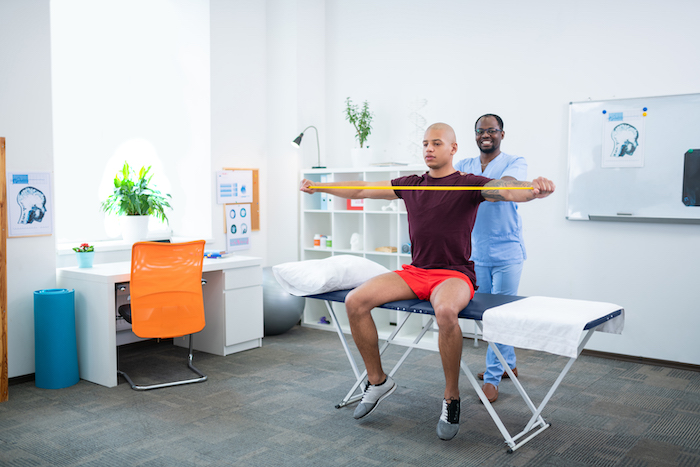Stretching is an integral a part of any exercise routine. Higher flexibility permits us to change into extra proof against harm whereas gaining power, however most individuals solely learn about two varieties of stretches:
- Static: Conventional stretching the place a muscle is held in an elongated place for as much as 30 seconds (assume toe-touches) to launch stress and make muscle tissues extra pliable.
- Dynamic: Motion-based actions (e.g., trunk twists, excessive knees) to prime the physique for motion.
However there’s one other technique to improve flexibility and vary of movement referred to as PNF stretching. Should you’ve ever labored out with a private coach who stretched you post-workout or visited one of many stylish stretching studios, chances are you’ll already be aware of this observe.
Whether or not you’re a novice or continuously have another person stretch you, right here’s what you could learn about PNF stretching.
What Is PNF Stretching?

Proprioceptive neuromuscular facilitation, or PNF stretching, includes stretching a muscle to its restrict after which contracting that muscle or a surrounding muscle to permit for a deeper stretch — much like lively stretching. The purpose of the observe is to unlock higher ranges of movement and enhance flexibility.
Bodily therapists developed PNF within the Forties as a technique to deal with sufferers with polio and a number of sclerosis and later started utilizing it for different situations. “PNF stretching is primarily utilized in rehabilitative and orthopedic settings to revive flexibility, power, and coordination to injured muscle tissues,” explains Chris Gagliardi, scientific schooling content material supervisor for the American Council on Train. Most frequently, this stretching is completed with a educated associate.
Nevertheless, anybody who needs to enhance mobility can profit from PNF methods. “It’s a therapy methodology and philosophy that makes use of the facility of the nervous system to boost motion,” says private coach and bodily therapist Keats Snideman, PT, DPT, COMT, CSCS, LMT.
He explains that breaking down the acronym helps to grasp the way it works:
- Proprioceptive: Referring to the numerous sensory receptors that relay details about the motion and place of the physique again to the central nervous system.
- Neuromuscular: The connection between the nerves and the muscle tissues/tendons that they provide.
- Facilitation: To make an motion or course of simpler.
How Does PNF Stretching Work?

Snideman splits PNF ideas into “direct” and “oblique” methods. Direct strategies use drive supplied by the muscle being stretched, whereas oblique strategies use drive supplied by muscle tissues that oppose the one being stretched.
Direct methods
Direct methods are used for tight muscle tissues that aren’t painful or harmful to stretch. A typical stretching methodology is contract-relax (CR):
- You stretch the tight muscle to its finish vary of movement or simply shy of it if that’s painful.
- Then from that place, isometrically contract the muscle (a.ok.a. push towards a drive with out shifting the muscle) for 5 to 10 seconds.
- After a short leisure, you’ll discover you can stretch the muscle a bit deeper.
For instance, in case you had been to stretch your hamstring, you’d lie in your again and elevate your leg up as excessive as it might go whereas conserving it straight. Then, push towards an opposing drive — like a associate, strap, or wall — as in case you had been going to decrease your leg again down, however make sure that your leg doesn’t transfer. After contracting for as much as 10 seconds, calm down your leg, and it’s best to be capable of elevate it increased than you probably did beforehand.
“This method works by what is named ‘post-isometric leisure,’” Snideman explains, “which signifies that a muscle has a short interval of leisure after isometric contraction.”
This leisure is feasible due to a reflex referred to as autogenic inhibition. When the muscle contracts, sensory receptors referred to as golgi tendon organs ship an inhibitory sign that directs the muscle to launch stress, permitting it to elongate. Put merely, the muscle relaxes itself when it experiences an excessive amount of stress.
You possibly can usually do direct PNF stretching with a associate or with props like a strap or a wall.
Oblique methods
Oblique methods use antagonist, or opposing, physique elements to stretch a decent muscle. “This method is perhaps higher when a muscle is weak or painful to contract,” Snideman says.
With oblique methods:
- You stretch the tight muscle to its finish vary of movement or simply shy of it if that’s painful.
- Then, reasonably than contracting that muscle, you isometrically contract different opposing muscle tissues for 5 to 10 seconds, which, in flip, assist the tight muscle calm down and stretch.
For instance, in case you had been to stretch your chest, you’d elevate your arm up in order that it’s parallel to the bottom and stretch it as far again behind as you’ll be able to with out ache. From that time, brace your arm towards a associate or a wall behind you and contract the muscle tissues in your shoulders and higher again to push towards the drive. After contracting for as much as 10 seconds, calm down your arm, and chances are you’ll discover extra vary of movement within the preliminary chest stretch.
Throughout this method, the muscle tissues interact in reciprocal inhibition. Whereas one muscle is contracting, inhibitory indicators trigger the opposing muscle to calm down.
Oblique PNF stretching is often carried out with a associate, however it might be attainable to stretch by yourself with props, relying on what muscle you’re focusing on.
When Ought to I Do PNF Stretching?
“There isn’t any consensus on when it’s best to make use of PNF stretching,” Snideman says. “But when this sort of stretching is used previous to exercise, it might assist somebody obtain the vary of movement they want for no matter exercise they’re about to partake in.”
It’s finest to heat up earlier than doing PNF stretching, as flexibility is most successfully educated when the muscle is heat, Gagliardi provides.
Additionally, earlier than train, remember to do some dynamic stretching after PNF stretching. In any other case, research present you could have much less vertical leap top or energy throughout your exercise.
What Are the Advantages of PNF Stretching?

“PNF-type stretching usually produces a higher improve in vary of movement extra shortly than passive or static approaches,” Snideman says.
In a research revealed in Biology of Sport in 2016, researchers divided 40 school college students with tight hamstrings into 4 teams. Three days per week for 4 weeks, college students carried out:
- Typical static stretching
- PNF stretching
- Mulligan traction straight leg increase (TSLR) approach (one other approach that will increase hamstring flexibility)
- No stretching
PNF stretching and Mulligan TSLR each elevated hamstring vary of movement greater than static stretching did. Some even contemplate PNF the “best stretching approach” for growing vary of movement.
Precautions When Practising PNF Stretching
To be secure, solely do PNF stretching with an expert, akin to a private coach or bodily therapist educated within the observe. Inform them about any accidents or strains, as contracting injured muscle tissues or tendons could worsen issues, Snideman cautions.
This additionally applies in case you’ve had latest surgical procedures, as stretching the affected muscle tissues could impair restoration. As soon as you recognize the methods, you might be able to do some PNF stretching by yourself.

